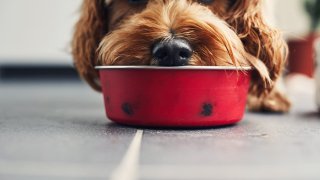
- Mars and Nestle pet food divisions have begun selling dog and cat food including insect protein as the idea of a 'carbon pawprint' is tested alongside the carbon footprint of climate-conscious consumers.
- The pet food market in the U.S. is estimated at $42 billion in sales, and a key U.S. animal food regulatory body has voted to accept dried black soldier fly larvae for use in adult dog food.
- Globally pets consume an estimated 20% of meat and fish in their countries.
What do black soldier fly grubs taste like? Stilton and cheese biscuits. At least that's how British start-up Yora Pet Foods describes its dog food made from the bugs.
Established in 2019, Yora introduced the first insect protein pet food sold in the U.K. Targeting environmentally conscious pet owners, it expects to have shipped over 200 tons of product to more than 200 countries and generate sales over $2.8 million. Its business is part of a movement in which manufacturers in North America, Europe and beyond are trying to make pet food more sustainable and environmentally friendly by using proteins from insects instead of animals.
"We expect that as consumers become more conscious of their own carbon footprints — and the carbon 'pawprints' of their pets — insect protein will be embraced by more and more pet owners as a viable and marketable alternative to traditional meat," says Yora managing director Glenn Rankin, adding that pets consume an estimated 20% of meat and fish in their countries.
Get New England news, weather forecasts and entertainment stories to your inbox. Sign up for NECN newsletters.
Livestock, climate and culinary changes
Despite concerns by some scientists about the many unknowns associated with farming them on a vast scale, insects are already an emerging trend in sustainable foods for people.
According to a 2017 Dutch review study, compared to livestock production the advantages of insect farming include: requiring less land and water, emitting less greenhouse gases, having high feed conversion efficiencies, and being useful as animal or aqua feed. A 2020 study by researchers in the U.K. and Germany, presenting what they called the first analysis of its kind, concluded that the impacts of pet food "are equivalent to an environmental footprint of around twice the U.K. land area, and would make greenhouse gas emission from pet food around the 60th highest emitting country, or equivalent to total emissions from countries such as Mozambique or the Philippines."
Money Report
Against this background, a European Commission panel recently endorsed draft legislation that would certify mealworm beetle larvae, aka yellow mealworm, as safe to eat — the first insect approved in the 27-nation bloc. The grubs can be eaten whole and dried or as an ingredient. "The use of insects as an alternate source of protein is not new and insects are regularly eaten in many parts of the world," the commission noted.
Backed by Robert Downey Jr.'s investment group Footprint Coalition, French insect food company Ynsect, which specializes in yellow mealworm, announced in April it has acquired Dutch rival Protifarm, a maker of mealworm ingredients for human applications. Ynsect will now have a total capacity of over 230,000 metric tons of ingredients per year.
For many people, though, bugs are less than appetizing. By comparison, getting our furry friends to feast on insects might be a walk in the park. Start-ups and long-established companies are introducing bugs to change the pet food market, which was worth some $42 billion in the U.S. in 2020, according to the American Pet Products Association.
"I would certainly consider feeding my dogs insects as a treat or training reward," says Laurie Dunbar, a veterinarian at Pierrefonds Animal Hospital in Montreal who isn't keen on eating bugs herself but thinks they make sense for dogs and other animals that naturally consume them. "I would also have no issues with insects as a protein source in a formula that was well balanced for the dog's age and lifestyle. ... I would feel comfortable recommending it to clients who are looking for environmentally sound alternatives to meat-based diets, and for pets with allergies to traditional protein sources."
Demand for insect protein
Demand for insect protein as an ingredient in pet food and animal feed could hit half a million metric tons in 2030, up from about 10,000 metric tons currently, according to a 2021 report by RaboResearch, a Dutch food and agribusiness research group. "The insect industry is on a path to increase scale, backed by investments and partnerships. Efficiency gains due to increasing technology, automation, improvements in genetics and legislative changes will also enable costs to decrease," the report noted, adding that doubling or quadrupling production volume will take much less time once the half-million threshold is reached.
"While the sustainability aspects and functional benefits support demand growth, high costs and prices, the current limited production capacity, and legislation are the main factors limiting growth of insect protein," RaboResearch said in introducing the report.
In March, Mars Petcare, part of confectionery giant Mars, announced Lovebug, a dry cat food made without traditional beef or poultry protein. It's created from black soldier fly larvae insect meal and sold in the U.K. The food is aimed at "pet parents" who care about sustainability since insects take up 80% less land than beef per kilogram of protein, according to Mars. In addition, the grubs are fed on surplus veggies and plants and sourced from a farm powered by 100% renewable electricity.
Last November, Nestlé introduced a Purina pet food containing fly larvae, plant and animal protein. Launched in Switzerland, Purina Beyond Nature's Protein for dogs and cats comes in two formulations: one based on chicken, pig liver and millet, and the other based on protein from black soldier fly larvae, chicken and fava beans.
"We carefully balanced the contribution of the different protein sources, including insects, in our cat and dog recipes to fulfill their specific nutritional needs," says Dan Smith, head of Nestlé's Global Strategic Business Unit for pet care. "Consumer acceptance is promising. We carried out some research in December 2020, and found that a significant majority of the Swiss consumers who tried the range confirmed that their pet liked the product and that they would repurchase the product."
U.S. pet food market
The pet industry has boomed during the pandemic, with purchase and adoption of pets rising, spending on pets hitting a record in 2020, and the trend so intense veterinarians have struggled to keep up with demand. Following the introduction of cricket-based pet treats in recent years, more insect pet food may come to North America during this peak pet era.
HOPE Pet Foods is a University of Toronto spinoff launched in 2020. This summer, it plans to release treats and food based on alternative proteins such as algae and black soldier fly larvae.
"We know dogs love the nutty taste of our products, which is characteristic of the insect ingredients we use," says HOPE co-founder and CEO Sofia Bonilla, who learned about the alternative proteins while working as a postdoctoral researcher in the Netherlands. "Alternative proteins can offer equal if not better nutritional profiles to the foods that we currently consume, and they are much less environmentally costly to produce."
Phillip Cooper, a pet industry expert based in California, says insect food sales in the U.S. account for less than 2% of sales but pet food manufacturers are always looking for new and better sources of protein.
"I do expect this trend to continue to grow and it seems cricket protein seems to be the most popular and the most plentiful," says Cooper. "Dogs will eat it, but the biggest obstacle is getting consumers to accept it with open arms."
He says "the healthy crowd" — consumers concerned about sustainability and the environment — will support new ideas, but most major retailers generally follow wait for broader adoption and are price conscious. "Until we see major investors invest in supply chain, packaging and advertising, I expect this segment to grow in single digits yearly," Cooper said.
U.S. regulations may soon change to allow more bugs in pet food. In general, ingredients used in animal food must be either approved food additives or be generally recognized as safe (GRAS), according to the Food and Drug Administration. In coordination with state feed control officials, the FDA recognizes ingredients in the Official Publication of the Association of American Feed Control Officials (AAFCO) as being acceptable for animal food.
The AAFCO's ingredient definition committee has voted to accept dried black soldier fly larvae for use in adult dog food. However, the ingredient has not yet been published by AAFCO because it has not gone through all of the necessary steps, an FDA spokesperson said. AAFCO did not respond to a request for comment.
"Use of insects in pet food would require assessment of safety and utility through a food additive petition unless the ingredient is GRAS for use in pet food in order to be legally marketed," the spokesperson said. "It is important to note that insect proteins, like animal or plant proteins, can come from a wide range of sources, so each type of insect protein (e.g., crickets, flies, worms, various types of larvae) would need to be evaluated and approved separately. In addition, how the insects are raised may impact safety and will need to be considered."






